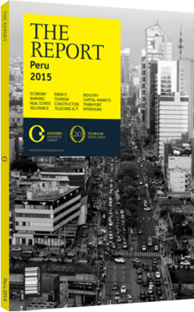Julio Velarde, Governor, Central Reserve Bank of Peru (BCRP): Interview

Interview: Julio Velarde
What can the country do to keep inflation in check?
JULIO VELARDE: Low inflation in Peru is the result of the BCRP’s credibility. It reflects both a strong institutional framework, which ensures central bank independence and the performance of monetary policy. The inflation targeting regime adopted in 2002 has been crucial to the BCRP’s good performance. Since adopting this strategy, underlying inflation has been 2%, with a 2.8% yearly average. The forecast for 2014 is around 3%. Price stability has also contributed to reducing financial dollarisation from 80% in the late 1990s to 40% in September 2014. The BCRP accumulates international reserves to reduce liquidity risks associated with dollarisation, and uses high reserve requirements in dollars to reduce banks’ incentives to lend in dollars. More recently, the BCRP has set a high reserve requirement for short-term loans in dollars and is intervening in the foreign exchange market to reduce exchange rate volatility, thereby limiting the potential negative balance sheet effects associated with financial dollarisation.
How can budget allocation be improved in Peru?
VELARDE: It is crucial to boost efficiency in the public sector, given the need for better public services. However, perhaps decentralisation was implemented too quickly, without giving local administrations the necessary training for managing public budgets efficiently. Steps are being taken to improve this, such as introducing certain control mechanisms from the centre, taking a firmer stand on corruption and promoting greater central government involvement in public spending decisions at the subnational level.
What are the pros and cons of having four banks control 80% of the country’s deposits and loans?
VELARDE: Less new banks have launched operations in the region following the global financial crisis, as the requirements to open new financial institutions have become more difficult to comply with. In Peru some new banks have entered the market, but they have not been able to gain much market share. The smaller banks are mainly international entities competing in the corporate segment of the market. At the same time, international banks, in combination with retail banks and smaller rural banks, have created a competitive market. Having a more concentrated banking sector can provide more stability when facing a financial crisis, as was the case in Canada in 2008. That being said, we do need to ensure that regulation remains favourable to the arrival and creation of new institutions.
Which monetary strategies should be implemented to increase foreign direct investment (FDI)?
VELARDE: The most important factor for attracting FDI is macroeconomic stability, as it is the best guarantee for sustainable growth. The country should also avoid unnecessary exchange and price controls. Low inflation and the openness of the foreign exchange market ensure that investors can withdraw funds at any time. Keeping in place sensible fiscal and monetary policies is the best way of attracting FDI.
Why did the World Bank cut Peru’s GDP forecast?
VELARDE: The slowdown in the first half of 2014 is explained mainly by temporary shocks. Mining was affected by an underperformance in gold production due to lower ore grades. Additionally, agriculture and fishing faced adverse weather conditions, with sizable drops in rice and coffee production of 15% and 20%, respectively, in the first quarter of 2014. Two additional factors that further explain the slowdown in 2014 are the fall in public spending associated with political uncertainty and a decrease in terms of trade, which has affected investment growth. The BCRP foresees a rebound in copper production as new projects initiate operations. This will contribute to a faster expansion of the mining industry in the coming years, in line with expectations of a recovery in export growth in 2015-16. The BCRP also expects public investment to recover in the coming months and terms of trade to stabilise.
What can the country do to keep inflation in check?
VELARDE: Low inflation in Peru is the result of the BCRP’s credibility. It reflects both a strong institutional framework, which ensures central bank independence and the performance of monetary policy. The inflation targeting regime adopted in 2002 has been crucial to the BCRP’s good performance. Since adopting this strategy, underlying inflation has been 2%, with a 2.8% yearly average. The forecast for 2014 is around 3%. Price stability has also contributed to reducing financial dollarisation from 80% in the late 1990s to 40% in September 2014. The BCRP accumulates international reserves to reduce liquidity risks associated with dollarisation, and uses high reserve requirements in dollars to reduce banks’ incentives to lend in dollars. More recently, the BCRP has set a high reserve requirement for short-term loans in dollars and is intervening in the foreign exchange market to reduce exchange rate volatility, thereby limiting the potential negative balance sheet effects associated with financial dollarisation.
How can budget allocation be improved in Peru?
VELARDE: It is crucial to boost efficiency in the public sector, given the need for better public services. However, perhaps decentralisation was implemented too quickly, without giving local administrations the necessary training for managing public budgets efficiently. Steps are being taken to improve this, such as introducing certain control mechanisms from the centre, taking a firmer stand on corruption and promoting greater central government involvement in public spending decisions at the subnational level.
What are the pros and cons of having four banks control 80% of the country’s deposits and loans?
VELARDE: Less new banks have launched operations in the region following the global financial crisis, as the requirements to open new financial institutions have become more difficult to comply with. In Peru some new banks have entered the market, but they have not been able to gain much market share. The smaller banks are mainly international entities competing in the corporate segment of the market. At the same time, international banks, in combination with retail banks and smaller rural banks, have created a competitive market. Having a more concentrated banking sector can provide more stability when facing a financial crisis, as was the case in Canada in 2008. That being said, we do need to ensure that regulation remains favourable to the arrival and creation of new institutions.
Which monetary strategies should be implemented to increase foreign direct investment (FDI)?
VELARDE: The most important factor for attracting FDI is macroeconomic stability, as it is the best guarantee for sustainable growth. The country should also avoid unnecessary exchange and price controls. Low inflation and the openness of the foreign exchange market ensure that investors can withdraw funds at any time. Keeping in place sensible fiscal and monetary policies is the best way of attracting FDI.
Why did the World Bank cut Peru’s GDP forecast?
VELARDE: The slowdown in the first half of 2014 is explained mainly by temporary shocks. Mining was affected by an underperformance in gold production due to lower ore grades. Additionally, agriculture and fishing faced adverse weather conditions, with sizable drops in rice and coffee production of 15% and 20%, respectively, in the first quarter of 2014. Two additional factors that further explain the slowdown in 2014 are the fall in public spending associated with political uncertainty and a decrease in terms of trade, which has affected investment growth. The BCRP foresees a rebound in copper production as new projects initiate operations. This will contribute to a faster expansion of the mining industry in the coming years, in line with expectations of a recovery in export growth in 2015-16. The BCRP also expects public investment to recover in the coming months and terms of trade to stabilise.
You have reached the limit of premium articles you can view for free.
Choose from the options below to purchase print or digital editions of our Reports. You can also purchase a website subscription giving you unlimited access to all of our Reports online for 12 months.
If you have already purchased this Report or have a website subscription, please login to continue.

